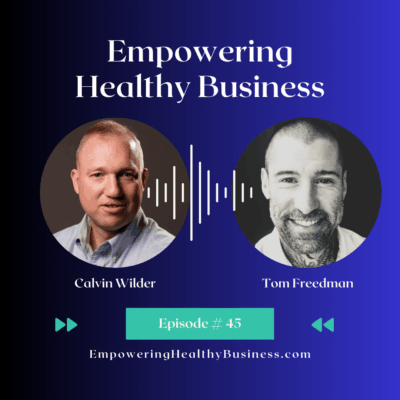Empowering Healthy Business Podcast Episode 45 : How to Win More Clients Through Referrals Not Cold Leads

If you run a B2B services business, you’ve likely poured time and money into “lead gen” only to watch unqualified inquiries clog your inbox. In this episode of the Empowering Healthy Business podcast, we talk with Tom Freedman of Defiant Enterprises about a better path: focusing on referrals not cold leads. Instead of chasing endless lists, a referral-based sales strategy helps you turn genuine conversations into paying clients. This post distills that discussion into a clear, practical playbook you can use right away.
Why Referrals Beat Cold Leads for Winning Clients
Most small businesses assume that if they generate more leads, they’ll automatically win more clients. But as Tom Freedman explains, that’s not how it works. In relationship-driven sales, the best clients almost always come through connections, introductions, and referrals. A warm introduction carries trust, shortens the sales cycle, and produces higher-value relationships.
On the other hand, chasing cold leads can drain time, money, and attention without producing much in return. For service businesses, quality matters more than quantity. A smaller number of genuine conversations often outperforms a large pile of unqualified leads, making referrals not cold leads the smarter path for growth.
The Five-Step Framework for a Referral-Based Sales Strategy
Tom uses a five-step process to make relationship selling repeatable and scalable.
1) Modeling: Reverse-Engineer Your Numbers
- Start with the end in mind: what do you want your business to return each month and year?
- Define a “growth unit”: one producer (you or a rep) can usually win 8–20 new clients per year.
- Price and package accordingly: if you need more than 20 wins, either raise deal size or add another producer.
2) Positioning: Package, Audience, Message
- Package for impact: bundle services so each client brings maximum value with less operational load.
- Choose the right audience: focus on the segment that’s easiest to access and most profitable.
- Sharpen the message: clear, concise, and compelling messaging sparks interest and avoids commoditization.
3) Managing: Set Up Your CRM for Relationships
- Create a “Sources” pipeline: track referral partners as assets—your unpaid sales team.
- Connect marketing touchpoints: link campaigns and website data to see what actually drives conversations.
- Be honest about nurturing: automate light touches if useful, but spend more time building strong referral relationships.
4) Methods: Conversations Over Cold Calls
- Identify synergistic partners who serve the same audience with complementary services.
- Build reciprocal value by sharing referrals, co-creating content, and hosting events.
- Provide crisp briefs your partners can forward, making introductions easier.
5) Multiplying: Scale by Adding Producers
- Document your growth process: model, message, CRM practices, and partner playbook.
- Hire producers who can follow the system, not reinvent it.
- Track net-new wins, churn, and deal value to measure growth properly.
Practical Steps You Can Take Right Away
You don’t need to overhaul your sales process overnight. The key is to start small and focus on actions that make an immediate difference. Begin by clarifying your target audience and crafting a clear, simple message about who you help and how. Next, identify a short list of potential referral partners—people or companies who already serve the same audience but in a complementary way.
Rather than treating them as one-off contacts, track these partners inside your CRM so you can see who’s sending you introductions and when you last connected. From there, set aside time to reach out, share how you can help them, and make it easy for them to pass along introductions. Even a handful of these focused efforts each week can create momentum that compounds over time.
Knowing When to Add Lead Generation
There is a stage where traditional lead generation—ads, campaigns, or automated outreach—becomes useful, but it usually comes later. First, you need to have your referral-based sales strategy working smoothly, with a clear process for handling conversations and converting them into clients. Once you can reliably manage introductions and track results, adding lead generation can help amplify what’s already working.
The difference is that you’ll be layering campaigns onto a system that already produces consistent wins, not hoping a flood of cold leads will fix a broken process.
A Clearer Focus for Long-Term Growth
The big takeaway is that small B2B service businesses grow best by concentrating on what really produces results: trusted conversations that lead to clients. By focusing on referrals not cold leads, refining your message, and treating introductions as a structured part of your sales process, you can create steady, profitable growth without burning out on endless prospect-chasing. Once that foundation is in place, scaling becomes much simpler—whether by adding producers, expanding your partner network, or carefully introducing new marketing efforts.
Want to go deeper? Listen to the full conversation with Tom Freedman on the Empowering Healthy Business Podcast.